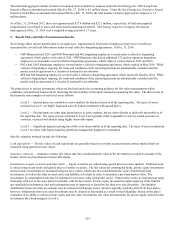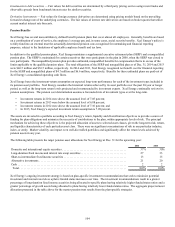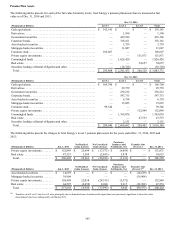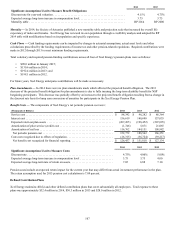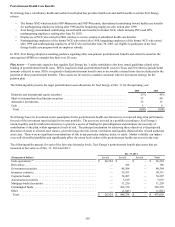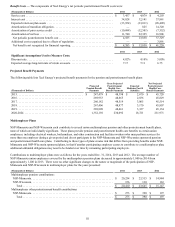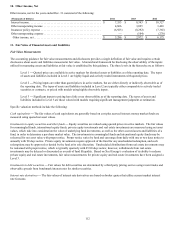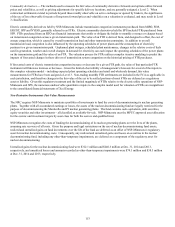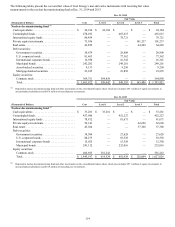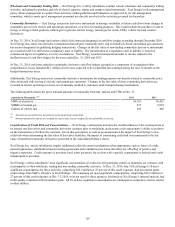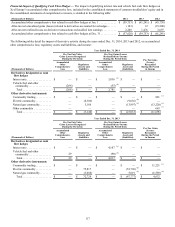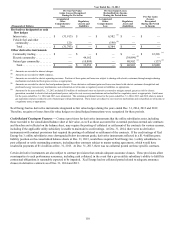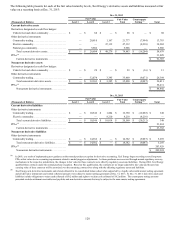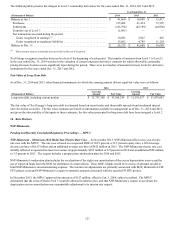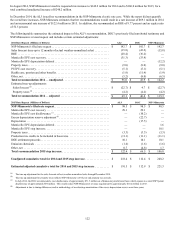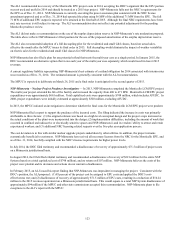Xcel Energy 2014 Annual Report Download - page 131
Download and view the complete annual report
Please find page 131 of the 2014 Xcel Energy annual report below. You can navigate through the pages in the report by either clicking on the pages listed below, or by using the keyword search tool below to find specific information within the annual report.113
Commodity derivatives — The methods used to measure the fair value of commodity derivative forwards and options utilize forward
prices and volatilities, as well as pricing adjustments for specific delivery locations, and are generally assigned a Level 2. When
contractual settlements extend to periods beyond those readily observable on active exchanges or quoted by brokers, the significance
of the use of less observable forecasts of long-term forward prices and volatilities on a valuation is evaluated, and may result in Level
3 classification.
Electric commodity derivatives held by NSP-Minnesota include transmission congestion instruments purchased from MISO, PJM,
ERCOT, SPP and NYISO, generally referred to as FTRs. Electric commodity derivatives held by SPS include FTRs purchased from
SPP. FTRs purchased from an RTO are financial instruments that entitle or obligate the holder to monthly revenues or charges based
on transmission congestion across a given transmission path. The value of an FTR is derived from, and designed to offset, the cost of
energy congestion, which is caused by overall transmission load and other transmission constraints. In addition to overall
transmission load, congestion is also influenced by the operating schedules of power plants and the consumption of electricity
pertinent to a given transmission path. Unplanned plant outages, scheduled plant maintenance, changes in the relative costs of fuels
used in generation, weather and overall changes in demand for electricity can each impact the operating schedules of the power plants
on the transmission grid and the value of an FTR. The valuation process for FTRs utilizes complex iterative modeling to predict the
impacts of forecasted changes in these drivers of transmission system congestion on the historical pricing of FTR purchases.
If forecasted costs of electric transmission congestion increase or decrease for a given FTR path, the value of that particular FTR
instrument will likewise increase or decrease. Given the limited observability of management’s forecasts for several of the inputs to
this complex valuation model – including expected plant operating schedules and retail and wholesale demand, fair value
measurements for FTRs have been assigned a Level 3. Non-trading monthly FTR settlements are included in the FCA as applicable in
each jurisdiction, and therefore changes in the fair value of the yet to be settled portions of most FTRs are deferred as a regulatory
asset or liability. Given this regulatory treatment and the limited magnitude of FTRs relative to the electric utility operations of NSP-
Minnesota and SPS, the numerous unobservable quantitative inputs to the complex model used for valuation of FTRs are insignificant
to the consolidated financial statements of Xcel Energy.
Non-Derivative Instruments Fair Value Measurements
The NRC requires NSP-Minnesota to maintain a portfolio of investments to fund the costs of decommissioning its nuclear generating
plants. Together with all accumulated earnings or losses, the assets of the nuclear decommissioning fund are legally restricted for the
purpose of decommissioning the Monticello and PI nuclear generating plants. The fund contains cash equivalents, debt securities,
equity securities and other investments – all classified as available-for-sale. NSP-Minnesota uses the MPUC approved asset allocation
for the escrow and investment targets by asset class for both the escrow and qualified trust.
NSP-Minnesota recognizes the costs of funding the decommissioning of its nuclear generating plants over the lives of the plants,
assuming rate recovery of all costs. Given the purpose and legal restrictions on the use of nuclear decommissioning fund assets,
realized and unrealized gains on fund investments over the life of the fund are deferred as an offset of NSP-Minnesota’s regulatory
asset for nuclear decommissioning costs. Consequently, any realized and unrealized gains and losses on securities in the nuclear
decommissioning fund, including any other-than-temporary impairments, are deferred as a component of the regulatory asset for
nuclear decommissioning.
Unrealized gains for the nuclear decommissioning fund were $312.1 million and $240.3 million at Dec. 31, 2014 and 2013,
respectively, and unrealized losses and amounts recorded as other-than-temporary impairments were $74.1 million and $58.5 million
at Dec. 31, 2014 and 2013, respectively.


